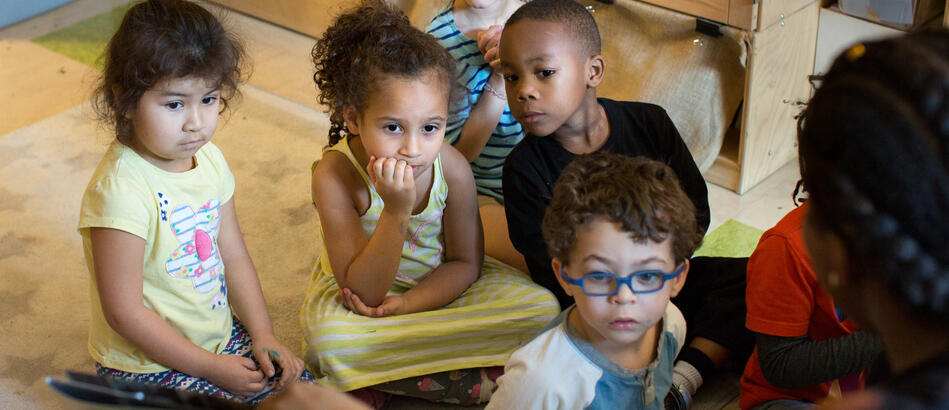
The evidence was clear: enrollment in full-day preschool had long-lasting benefits for students, especially students who started off the farthest behind. Beginning in 2013, Chicago Public Schools officials invested in new policies and programs that resulted in quadrupling full-day programs, most notably on the West and South Sides of Chicago in primarily Black neighborhoods with the lowest income levels. Full-day preschool enrollment became more equitable, and preschool daily attendance rates rose to their highest levels ever. The outlook seemed promising; the district was poised to see greater equity in early learning outcomes. Then the COVID-19 pandemic hit.
With the COVID-19 pandemic, schools faced unprecedented challenges in ensuring continued engagement in remote learning. Our UChicago Consortium research team worked with leaders at Chicago Public Schools to investigate how student enrollment, attendance, grades, and enrollment were affected during the period of remote instruction. While data on engagement and performance were primarily available for students in grades three and higher, it was clear that the youngest learners in preschool and early primary grades were particularly impacted:
- There was a large decline in preschool enrollment during the pandemic. This alarmed us because our earlier research showed that preschool participation had positive effects on students' long-term achievement, with particularly large benefits for students from the lowest-income neighborhoods, Black students, and English language learners.
- Students in Kindergarten and first grade spent less time using the online learning platform than students in other grades during remote learning; unsurprisingly, online learning was particularly difficult for them.
To what extent did COVID-19 disrupt learning of K-2 students?
We are anxious to understand what happened to early literacy outcomes given the loss of opportunity for students who would have enrolled in preschool, or attended kindergarten and first grade more regularly in the absence of the pandemic. One area of work we are undertaking is better understand assessment data for these early grades so we can accurately determine what happened to young students’ literacy skills. We also believe it is critical to examine changes in students’ teacher-assigned course grades on literacy standards, and student attendance, since our prior work shows these other measures of achievement matter greatly for learning and achievement in later years. The study focuses specifically on the outcomes of four priority groups of students whose learning was likely most affected by the pandemic.
- Black students in communities with the highest economic hardship
- Latinx students in communities with the highest economic hardship
- English Learners
- Students whose literacy skills were in the bottom quartile on fall kindergarten assessments
Knowing whether and how much literacy outcomes were affected is a pressing question. But perhaps even more critical is supporting efforts at schools working to re-engage and catch students up. How can the district accelerate the learning of thousands and thousands of students? The factor that likely matters the most is the quality of the instruction that students get day in and day out from their classroom teacher. The district decided to focus on supporting instructional strategies through high-quality curricular materials, aligned formative assessments, and professional learning around those materials. This aligns closely with the first two approaches for in-school acceleration suggested in the US Department of Education handbook. District officials were careful to choose materials that would promote a culturally responsive approach to instruction, choosing reading materials that were modern and relevant to students’ lived experiences. “Skyline” is what the district calls this new system for supporting instructional change through curricular resources.
How are district efforts to provide high-quality curricular materials and professional learning working in practice?
Districts across the country have invested in curricular materials and professional learning—it is critical to understand what factors influence their effectiveness, and what makes a difference for student learning. Chicago is a decentralized district where schools may opt-in to Skyline. Therefore, we anticipate considerable variation across the district in the use of the resources and professional learning from which we can learn about what supports instructional improvement, and what does not, asking:
- To what extent are priority learners experiencing the K-2 ELA Skyline curriculum?
- To what extent does exposure to Skyline accelerate learning of K-2 students in priority groups?
- What instructional practices are associated with Skyline implementation?
- How do teachers’ perceptions of Skyline, their use of professional learning resources, and their collaboration with school colleagues shape their engagement with the resources?
- To what extent do Skyline-adopting teachers feel more supported in their work?
Our earlier research found that teacher buy-in and collaboration at the school level was critical for improved instructional practices. We are eager to learn how teachers perceive and use these new resources, and whether teachers use them to better support stronger instructional practices. Materials alone do not produce high-quality instruction, and we need to learn from teachers and instructional coaches what is working and what is not. We hope to see accelerated learning among student groups whose learning was most interrupted by the pandemic, so that the district regains the progress it was making towards increasing equity in literacy outcomes among its youngest learners. We also hope to provide evidence that leads investments in literacy curricular materials in the future to result in to better experiences and outcomes for the youngest learners.
Elaine Allensworth, Ph.D. is the Lewis-Sebring Director of the University of Chicago Consortium on Chicago School Research, where she has conducted research on educational policy and practice for over 25 years. Her research examines factors influencing students’ educational attainment, school leadership, and school improvement.
